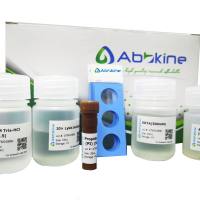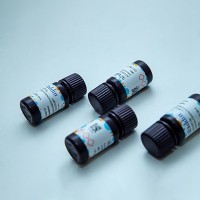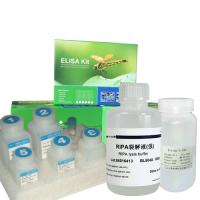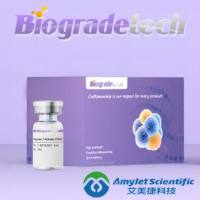鉴定分析植物蛋白复合物的蓝绿非变性凝胶电泳
丁香园
4221
1. 前言
蓝绿非变性聚丙烯酰胺凝胶电泳(BN- PAGE) 最先由 Hermann ScMgger 开发出来,并被用于优化线粒体和细菌的膜结合蛋白质的分析和鉴定。这种方法的最初理念是在电泳之前,先将蛋白复合物与蛋白质染料考马斯亮蓝混合在一起。在中性 pH 点上,考马斯亮蓝是一种带负电荷的分子,这时它可将负电荷引入到蛋白质复合物中。与十二烷基硫酸钠(SDS) 的作用相反,那些负电荷不结合到去折叠或解体的蛋白质复合物上。如果考马斯亮蓝渗透进去的蛋白质组分能在低百分浓度的聚丙烯酰胺凝胶上被分离,那么蛋白复合物的亚基就会在 SDS 存在的情况下,通过第一相的 BN-PAGE 电泳和第二相的 SDS-PAGE 电泳被分离出来。在 2D 凝胶上,蛋白点沿着竖条排列,便于指认这些蛋白复合物。第一相凝胶能分离天然状态下的蛋白质和蛋白复合物,并可用多种 胶内染料染色,BN- PAGE 对分离膜结合蛋白复合物特别有用,因为这些蛋白复合物常常缺乏用电泳方法分离天然蛋白质所必需的内部电荷。制备膜组分样品时,需要在考马斯亮蓝染色前,添加去垢剂来增溶膜蛋白,一般使用与天然蛋白质条件一致的温和的非极性去垢剂。BN-PAGE 也被发现对分离可溶性蛋白质和蛋白复合物很有用。
如今 BN-PAGE 是一种对研究蛋白质组分非常重要的基础生化方法,已在蛋白质组学中广泛应用,其应用范围包括:植物线粒体、质体、细胞质膜、质外体及多种有特定生化特性的组分。BN-PAGE 的科学目的一方面要实现对细胞及亚细胞组分中蛋白复合物的系统分析(图 26-1),另一方面也要实现对具体蛋白复合物的特殊分析。在对具体蛋白复合物进行特殊分析方面,BN-PAGE 可替代像分析超速离心和凝胶过滤色谱层析这样的分离蛋白复合物的其他生化方法。与这两种方法相比,BNPAGE 具有更高的分辨率。
2. 材料
2.1 BN-PAGE 样品的制备
( 1 ) 十二烷基 β-D-麦芽糖苷增溶液:1.0% 十二烷基 β-D-麦芽糖苷(RoChe,BaSel,Switzerland) , 50 mmol/L BisTris,750 mmol/L 氨基乙酸,0.5 mmol/L EDTA,pH 7.0,4°C 贮藏备用。使用前加入苯甲基磺酰氟(PMSF) [ 终浓度为 2 mmol/L,储液配制:200 mmol/L PMSF ( m/V ) 溶解在乙醇溶液中]。
( 2 ) TritonX-100 增溶液:1.0% TritonX-100 ( Sigma, St. Louis, MO ),50 mmol/L 咪唑盐酸,50 mmol/L 氯化钠,2 mmol/L 氨基乙酸,0.5 mmol/L EDTA,10% ( V/V ) 甘油,pH 7.4,4°C 贮藏备用。使用前加入苯甲基磺酰氟(PMSF) [ 终浓度为 2 mmol/L,储液配制:200 mmol/L PMSF ( m/V ) 溶解在乙醇溶液中]。
( 3 ) 洋地黄阜苷增溶液:5.0% 洋地黄阜苷(Fluka,Buchs,Switzerland) ,30 mmol/L HEPPS,150 mmol/L 乙酸钾,10% ( V/V ) 甘油,pH 7.4,4°C 贮藏备用。这个增溶液要新鲜配制,配制时短时间加热到 98°C,溶解洋地黄皂苷。使用前加入苯甲基磺酰氟(PMSF) [ 终浓度为 2 mmol/L,储液配制:200 mmol/L PMSF ( m/V ) 溶解在乙醇溶液中]。
( 4 ) 考马斯亮蓝染色液:5% 考马斯亮蓝 G-250 (Merck, Darmstadt, Germany) ,750 mmol/L 氨基乙酸。
2.2 BN-PAGA
( 1 ) 丙烯酰胺溶液:49.5% 丙烯酰胺/甲叉双丙烯酰胺(32 : 1)。
( 2 ) BN 凝胶缓冲液(6 X ): 1.5 mmol/L 氨基乙酸,150 mmol/L BisTris,pH 7.0,4°C 贮藏备用。
( 3 ) BN 阴极缓冲液(5 X ): 250 mmol/L Tricine,75 mmol/L BisTris,0.1% ( m/V) 考马斯亮蓝 G-250 (Merck, Darmstadt,Germany), pH 7.0,4°C 贮藏备用。
( 4 ) BN 阳极缓冲液(6 X ): 300 mmol/L BisTris,pH 7.0,4°C 贮藏备用。
2.3 第二相的 SDS-PAGE
( 1 ) 丙烯酰胺溶液:49.5% 丙烯酰胺/甲叉双丙烯酰胺(32 : 1)。
( 2 ) SDS 凝胶缓冲液:3 mol/L Tris-HCl,0.3% ( m/V)SDS,pH 8.45。
( 3 ) BN 凝胶缓冲液(6 X ) : 见 26. 2. 2。
( 4 ) SDS 阴极缓冲液:0.1 mol/L Tris-HCl,0.1 mol/L Tricine,0.1% (m/V) SDS,pH 8.25。
( 5 ) SDS 阳极缓冲液:0.2 mol/L Tris-HCl,pH 8.9。
( 6 ) 封胶液:1 mol/L Tris-HCl,0.1% ( m/V ) SDS,pH 8.45。
( 7 ) 变性处理液:1.0% ( m/V ) SDS,1.0% ( m/V ) β-疏基乙醇。
( 8 ) SDS 溶液:10% ( m/V ) SDS。
2.4 染色
( 1 ) 溶液 A:2% ( m/V)磷酸,10% 硫酸铵。
( 2 ) 溶液 B:5% ( m/V ) 考马斯亮蓝 G-250 ( Merck) 。
( 3 ) 固定液:40%(V/V ) ,甲醇,10% 乙酸。
( 4 ) 染色液:98% ( V/V ) 溶液 A,2% ( V/V)溶液 B,使用前一天配制染色液,振摇数小时,最好过夜振摇。
4. 注释
( 1 ) 用于增溶膜蛋白的去垢剂浓度要进行优化调整。十二烷基 β-D-麦芽糖苷和 Triton X-100 的使用浓度通常在 0.1%~2.0%,洋地黄皂苷的使用浓度通常在 1%~10%。
( 2 ) 若要分离大分子质量的蛋白质复合物( > 3 MDa) ,用 BN 胶缓冲液配制 2.5% 琼脂糖凝胶代替聚丙烯酰胺梯度胶 [28] 。
( 3 ) BN 胶能在天然或变性(SDS 存在)的条件下,被印迹转移。为去除胶上过多的考马斯亮蓝,需要进行简短的预印迹处理,或在电泳完成一半时,用不含考马斯亮蓝的 BN 阳极缓冲液替代原先使用的 BN 阳极缓冲液。从 1D BN 胶上切下来的蛋白复合物可被进一步的电洗脱、沉淀和凝胶分析,如 2D IEF/SDS-PAGE。一种相应的 3D 系统 ( BN/IEF/SDS-PAGE) 被认为对分离拟南芥中蛋白复合物的亚基成分的异构体有用 [29] 。
( 4 ) BN-PAGE 与胶内酶学染色兼容,方法见参考文献 3。
( 5 ) 当将 Tricine SDS-PAGE 用作第二向凝胶电泳时,Schagger 和 von Jagow 最先建议使用由 16% 和 10% 凝胶组成的二向分离胶。这种稍微复杂些的凝胶系统可较好地分离大蛋白质的亚基,其中一种凝胶灌在另一种凝胶上方。在 16% 的凝胶溶液中加入甘油,防止它与 10% 凝胶溶液相混,具体见 Schagger 和 von Jagow 的文章[ 25 ] 。
( 6 ) 将 BN 胶条嵌入到第二向凝胶的样品槽位置,以实现 BN 胶条转移到第二向凝胶上,这样做是为了使 BN 胶条与第二向的 SDS 凝胶能更好地胶面接触。但是,正如通常在 2D IEF/SDS-PAG 所做的,BN 胶条也可以用琼脂糖将其固定在第二向的 SDS 凝胶上。这两种凝胶的胶面接触可能无需改进了,但要在完成第一向电泳后,尽快进行第二向电泳。
( 7 ) 第一和第二向同为 BN-PAGE 的也可以结合起来使用 [30] ,在这种情况下,两向 BN 胶电泳通常是在不同去垢剂存在下进行的。例如,第一向 BN-PAGE 可在洋地黄皂苷存在下进行,而第二向可在十二烷基 β-D-麦芽糖苷存在下进行。所有同时在这两种去垢剂中状态稳定的蛋白复合物最终定位在这个凝胶系统的一条斜线上。相反,那些在第二种去垢剂中不稳定的蛋白复合物被分解为具有较高电泳迁移的亚复合物。这种 2D 凝胶系统能很好地用来研究蛋白复合物的高级结构。
( 8 ) 增加染色时间到 3 天,可进一步加强蛋白质检测的敏感性。
参考文献
1. Schagger, H. and von Jagow, G. (1991) Blue native electrophoresis for isolation of m e m b r a n e protein complexes in enzymatically active form. Anal. Biochem.199, 223-231.
2. Grandier-Vazeille, X. and Guerin, M . (1996) Separation by blue native and colorless native polyacrylamide gel electrophoresis of the oxidative phosphorylation complexes of yeast mitochondria solubilized by different detergents: specific staining of the different complexes. Anal. Biochem.242, 248-254.
3. Zerbetto, E., Vergani, L., and Dabbeni-Sala, F. (1997) Quantitation of muscle mitochondrial oxidative phosphorylation enzymes via histochemical staining of blue native polyacrylamide gels. Electrophoresis18, 2059-2064.
4. Fecht-Christoffers, M . M., Braun, H. P., Guillier, C., VanDorssealer, A., and Horst W . J. (2003) Effect of manganese toxicity on the proteome of the leaf apoplast in c o w p e a (Vigna unguiculata). Plant Physiol.133, 1935-1946.
5. Jansch, L., Kruft, V., Schmitz, U. K., and Braun, H. P. (1996) N e w insights into the composition, molecular mass and stoichiometry of the protein complexes of plant mitochondria. Plant J.9, 357-368.
6. Eubel, H., Jansch, L., and Braun, H. P. (2003) N e w insights into the respiratory chain of plant mitochondria: supercomplexes and a unique composition of complex II. Plant Physiol.133, 274-286.
7. Heazlewood, J. L., Howell, K. A., Whelan, J., and Millar, A. H. (2003) Towards an analysis of the rice mitochondrial proteome. Plant Physiol.132, 230-242.
8. Giege, P., Sweetlove, L. J., and Leaver, C. (2003) Identification of mitochondrial protein complexes in Arabidopsisusing two-dimensional blue-native polyacrylamide gel electrophoresis. Plant Mol. Biol. Rep.21, 133-144.
9. Sabar, M., Gagliardi, D., Balk. J., and Leaver, C. J. (2003) O R F B is a subunit of F(1)F(0)-ATP synthase: insight into the basis of cytoplasmic male sterility in sunflower. EMBO Rep. 4 , 1-6.
10. Dudkina, N. V., Eubel, H., Keegstra, W., Boekema, E. J., and Braun, H. P. (2005) Structure of a mitochondrial supercomplex formed by respiratory chain complexes I and III. Proc. Natl. Acad. Sci. USA 1 02 , 3225-3229.
11. Kiigler, M., Jansch, L., Kruft, V., Schmitz, U. K., and Braun, H. P. (1997) Analysis of the chloroplast protein complexes by blue-native polyacrylamide gelelectrophoresis. Photosynthesis Res.53, 35-44.
12. Rexroth, S., M e y e r zu Tittingdorf, J. M., Krause, F., Dencher, N. A., and Seelert, H. (2003) Thylakoid m e m b r a n e at altered metabolic state: challenging the forgotten realms of the proteome. Electrophoresis 24 , 2814-2823.
13. Ossenbiihl, F., Gohre, V., Meurer, J., Krieger-Liszkay, A., Rochaix, J. D., and Eichacker, L. A. (2004) Efficient assembly of photosystem II in Chlamydomonasreinhardtiirequires Alb3.1p, a h o m olog of ArabidopsisA L B I N 0 3 . Plant Cell 16, 1790-1800.
14. Heinemeyer, J., Eubel, H., W e h m h o n e r , D., Jansch, L., and Braun, H. P. (2004) Proteomic approach to characterize the supramolecular organization of photosystems in higher plants. Phytochemistry65, 1683-1692.
15. Ciambella, C., Roepstorff, P., Aro, E. M., and Zolla, L. (2005) A proteomic approach for investigation of photosynthetic apparatus in plants. Proteomics 5,746-757.
16. Kjell, J., Rasmusson, A. G., Larsson, H., and Widell, S. (2004) Protein complexes of the plant plasma m e m b r a n e resolved by blue native P A G E . Physiol. Plant 1 2 1, 546— 555.
17. Rivas, S., Romeis, T., and Jones, J. D. (2002) T h e Cf-9 disease resistance protein is present in an approximately 420-kilodalton heteromultimeric membrane-associated complex at one molecule per complex. Plant Cell 1 4 , 689-702.
18. Piotrowski, M., Janowitz, T., and Kneifel, H. (2003) Plant C - N hydrolases and the identification of a plant N-carbamoylputrescine amidohydrolase involved in polyamine biosynthesis. /. Biol. Chem. 278, 1708-1712.
19. Drykova, D., Cenklova, V., Sulimenko, V., Vole, J., Draber, P., and Binarova, P. (2003) Plant gamma-tubulin interacts with alphabeta-tubulin dimers and forms membrane-associated complexes. Plant Cell 15, 465-480.
20. Salomon, M., Lempert, U., and Rudiger, W . (2004) Dimerization of the plant photoreceptor phototropin is probably mediated by the L O V 1 domain. FEBS Lett.57 2, 8-10.
21. Boldt, A., Fortunato, D., Conti, A., et al. (2005) Analysis of the composition of an immunoglobulin E reactive high molecular weight protein complex of peanut extract containing Ara h 1 and Ara h 3/4. Proteomics 5, 675-686.
22. Werhahn, W . H., Niemeyer, A., Jansch, L., Kruft, V., Schmitz, U. K., and Braun, H. P. (2001) Purification and characterization of the preprotein translocase of the outer mitochondrial m e m b r a n e from Arabidopsis thaliana: identification of multiple forms of T O M 2 0 . Plant Physiol. 1 2 5, 943-954.
23. Lowry, O. H., Rosebrough, N. J., Farr, A. L., and Randall, R. J. (1951) Protein measurement with the Folin phenol reagent. J. Biol. Chem. 1 9 3, 265-275.
24. Laemmli, U. K. (1970) Cleavage of structural proteins during the assembly of the head of bacteriophage T4. Nature 221,680— 685.
25. Schagger, H. and von Jagow, G. (1987) Tricine-sodium dodecyl sulfate-polyacry-lamide gel electrophoresis for the separation of proteins in the range from 1 to 100 kDa. Anal. Biochem.166, 368-379.
26. Neuhoff, V., Stamm, R., and Eibl, H. (1985) Clear background and highly sensitive protein staining with Coomassie Blue dyes in polyacrylamide gels: a systematic analysis. Electrophoresis6, 427-448.
27. Neuhoff, V., Stamm, R., Pardowitz, I., Arold, N., Ehrhardt, W., and Taube, D. (1990) Essential problems in quantification of proteins following colloidal staining with Coomassie Brilliant Blue dyes in polyacrylamide gels, and their solution. Electrophoresis11, 101-117.
28. Henderson, N. S., Nijtmans, L. G., Lindsay, J. G., Lamantea, E., Zeviani, M., and Holt, I. J. (2000) Separation of intact pyruvate dehydrogenase complex using blue native agarose gel electrophoresis. Electrophoresis21, 2925-2931.
29. Werhahn, W . and Braun, H. P. (2002) Biochemical dissection of the mitochondrial proteome from Arabidopsis thalianaby three-dimensional gel electrophoresis. Electrophoresis23, 640— 646.
30. Schagger, H. and Pfeiffer, K. (2000) Supercomplexes in the respiratory chain of yeasts and m a m m a l i a n mitochondria. EMBO J.19, 1777-1783.
蓝绿非变性聚丙烯酰胺凝胶电泳(BN- PAGE) 最先由 Hermann ScMgger 开发出来,并被用于优化线粒体和细菌的膜结合蛋白质的分析和鉴定。这种方法的最初理念是在电泳之前,先将蛋白复合物与蛋白质染料考马斯亮蓝混合在一起。在中性 pH 点上,考马斯亮蓝是一种带负电荷的分子,这时它可将负电荷引入到蛋白质复合物中。与十二烷基硫酸钠(SDS) 的作用相反,那些负电荷不结合到去折叠或解体的蛋白质复合物上。如果考马斯亮蓝渗透进去的蛋白质组分能在低百分浓度的聚丙烯酰胺凝胶上被分离,那么蛋白复合物的亚基就会在 SDS 存在的情况下,通过第一相的 BN-PAGE 电泳和第二相的 SDS-PAGE 电泳被分离出来。在 2D 凝胶上,蛋白点沿着竖条排列,便于指认这些蛋白复合物。第一相凝胶能分离天然状态下的蛋白质和蛋白复合物,并可用多种 胶内染料染色,BN- PAGE 对分离膜结合蛋白复合物特别有用,因为这些蛋白复合物常常缺乏用电泳方法分离天然蛋白质所必需的内部电荷。制备膜组分样品时,需要在考马斯亮蓝染色前,添加去垢剂来增溶膜蛋白,一般使用与天然蛋白质条件一致的温和的非极性去垢剂。BN-PAGE 也被发现对分离可溶性蛋白质和蛋白复合物很有用。
如今 BN-PAGE 是一种对研究蛋白质组分非常重要的基础生化方法,已在蛋白质组学中广泛应用,其应用范围包括:植物线粒体、质体、细胞质膜、质外体及多种有特定生化特性的组分。BN-PAGE 的科学目的一方面要实现对细胞及亚细胞组分中蛋白复合物的系统分析(图 26-1),另一方面也要实现对具体蛋白复合物的特殊分析。在对具体蛋白复合物进行特殊分析方面,BN-PAGE 可替代像分析超速离心和凝胶过滤色谱层析这样的分离蛋白复合物的其他生化方法。与这两种方法相比,BNPAGE 具有更高的分辨率。
2. 材料
2.1 BN-PAGE 样品的制备
( 1 ) 十二烷基 β-D-麦芽糖苷增溶液:1.0% 十二烷基 β-D-麦芽糖苷(RoChe,BaSel,Switzerland) , 50 mmol/L BisTris,750 mmol/L 氨基乙酸,0.5 mmol/L EDTA,pH 7.0,4°C 贮藏备用。使用前加入苯甲基磺酰氟(PMSF) [ 终浓度为 2 mmol/L,储液配制:200 mmol/L PMSF ( m/V ) 溶解在乙醇溶液中]。
( 2 ) TritonX-100 增溶液:1.0% TritonX-100 ( Sigma, St. Louis, MO ),50 mmol/L 咪唑盐酸,50 mmol/L 氯化钠,2 mmol/L 氨基乙酸,0.5 mmol/L EDTA,10% ( V/V ) 甘油,pH 7.4,4°C 贮藏备用。使用前加入苯甲基磺酰氟(PMSF) [ 终浓度为 2 mmol/L,储液配制:200 mmol/L PMSF ( m/V ) 溶解在乙醇溶液中]。
( 3 ) 洋地黄阜苷增溶液:5.0% 洋地黄阜苷(Fluka,Buchs,Switzerland) ,30 mmol/L HEPPS,150 mmol/L 乙酸钾,10% ( V/V ) 甘油,pH 7.4,4°C 贮藏备用。这个增溶液要新鲜配制,配制时短时间加热到 98°C,溶解洋地黄皂苷。使用前加入苯甲基磺酰氟(PMSF) [ 终浓度为 2 mmol/L,储液配制:200 mmol/L PMSF ( m/V ) 溶解在乙醇溶液中]。
( 4 ) 考马斯亮蓝染色液:5% 考马斯亮蓝 G-250 (Merck, Darmstadt, Germany) ,750 mmol/L 氨基乙酸。
2.2 BN-PAGA
( 1 ) 丙烯酰胺溶液:49.5% 丙烯酰胺/甲叉双丙烯酰胺(32 : 1)。
( 2 ) BN 凝胶缓冲液(6 X ): 1.5 mmol/L 氨基乙酸,150 mmol/L BisTris,pH 7.0,4°C 贮藏备用。
( 3 ) BN 阴极缓冲液(5 X ): 250 mmol/L Tricine,75 mmol/L BisTris,0.1% ( m/V) 考马斯亮蓝 G-250 (Merck, Darmstadt,Germany), pH 7.0,4°C 贮藏备用。
( 4 ) BN 阳极缓冲液(6 X ): 300 mmol/L BisTris,pH 7.0,4°C 贮藏备用。
2.3 第二相的 SDS-PAGE
( 1 ) 丙烯酰胺溶液:49.5% 丙烯酰胺/甲叉双丙烯酰胺(32 : 1)。
( 2 ) SDS 凝胶缓冲液:3 mol/L Tris-HCl,0.3% ( m/V)SDS,pH 8.45。
( 3 ) BN 凝胶缓冲液(6 X ) : 见 26. 2. 2。
( 4 ) SDS 阴极缓冲液:0.1 mol/L Tris-HCl,0.1 mol/L Tricine,0.1% (m/V) SDS,pH 8.25。
( 5 ) SDS 阳极缓冲液:0.2 mol/L Tris-HCl,pH 8.9。
( 6 ) 封胶液:1 mol/L Tris-HCl,0.1% ( m/V ) SDS,pH 8.45。
( 7 ) 变性处理液:1.0% ( m/V ) SDS,1.0% ( m/V ) β-疏基乙醇。
( 8 ) SDS 溶液:10% ( m/V ) SDS。
2.4 染色
( 1 ) 溶液 A:2% ( m/V)磷酸,10% 硫酸铵。
( 2 ) 溶液 B:5% ( m/V ) 考马斯亮蓝 G-250 ( Merck) 。
( 3 ) 固定液:40%(V/V ) ,甲醇,10% 乙酸。
( 4 ) 染色液:98% ( V/V ) 溶液 A,2% ( V/V)溶液 B,使用前一天配制染色液,振摇数小时,最好过夜振摇。
4. 注释
( 1 ) 用于增溶膜蛋白的去垢剂浓度要进行优化调整。十二烷基 β-D-麦芽糖苷和 Triton X-100 的使用浓度通常在 0.1%~2.0%,洋地黄皂苷的使用浓度通常在 1%~10%。
( 2 ) 若要分离大分子质量的蛋白质复合物( > 3 MDa) ,用 BN 胶缓冲液配制 2.5% 琼脂糖凝胶代替聚丙烯酰胺梯度胶 [28] 。
( 3 ) BN 胶能在天然或变性(SDS 存在)的条件下,被印迹转移。为去除胶上过多的考马斯亮蓝,需要进行简短的预印迹处理,或在电泳完成一半时,用不含考马斯亮蓝的 BN 阳极缓冲液替代原先使用的 BN 阳极缓冲液。从 1D BN 胶上切下来的蛋白复合物可被进一步的电洗脱、沉淀和凝胶分析,如 2D IEF/SDS-PAGE。一种相应的 3D 系统 ( BN/IEF/SDS-PAGE) 被认为对分离拟南芥中蛋白复合物的亚基成分的异构体有用 [29] 。
( 4 ) BN-PAGE 与胶内酶学染色兼容,方法见参考文献 3。
( 5 ) 当将 Tricine SDS-PAGE 用作第二向凝胶电泳时,Schagger 和 von Jagow 最先建议使用由 16% 和 10% 凝胶组成的二向分离胶。这种稍微复杂些的凝胶系统可较好地分离大蛋白质的亚基,其中一种凝胶灌在另一种凝胶上方。在 16% 的凝胶溶液中加入甘油,防止它与 10% 凝胶溶液相混,具体见 Schagger 和 von Jagow 的文章[ 25 ] 。
( 6 ) 将 BN 胶条嵌入到第二向凝胶的样品槽位置,以实现 BN 胶条转移到第二向凝胶上,这样做是为了使 BN 胶条与第二向的 SDS 凝胶能更好地胶面接触。但是,正如通常在 2D IEF/SDS-PAG 所做的,BN 胶条也可以用琼脂糖将其固定在第二向的 SDS 凝胶上。这两种凝胶的胶面接触可能无需改进了,但要在完成第一向电泳后,尽快进行第二向电泳。
( 7 ) 第一和第二向同为 BN-PAGE 的也可以结合起来使用 [30] ,在这种情况下,两向 BN 胶电泳通常是在不同去垢剂存在下进行的。例如,第一向 BN-PAGE 可在洋地黄皂苷存在下进行,而第二向可在十二烷基 β-D-麦芽糖苷存在下进行。所有同时在这两种去垢剂中状态稳定的蛋白复合物最终定位在这个凝胶系统的一条斜线上。相反,那些在第二种去垢剂中不稳定的蛋白复合物被分解为具有较高电泳迁移的亚复合物。这种 2D 凝胶系统能很好地用来研究蛋白复合物的高级结构。
( 8 ) 增加染色时间到 3 天,可进一步加强蛋白质检测的敏感性。
参考文献
1. Schagger, H. and von Jagow, G. (1991) Blue native electrophoresis for isolation of m e m b r a n e protein complexes in enzymatically active form. Anal. Biochem.199, 223-231.
2. Grandier-Vazeille, X. and Guerin, M . (1996) Separation by blue native and colorless native polyacrylamide gel electrophoresis of the oxidative phosphorylation complexes of yeast mitochondria solubilized by different detergents: specific staining of the different complexes. Anal. Biochem.242, 248-254.
3. Zerbetto, E., Vergani, L., and Dabbeni-Sala, F. (1997) Quantitation of muscle mitochondrial oxidative phosphorylation enzymes via histochemical staining of blue native polyacrylamide gels. Electrophoresis18, 2059-2064.
4. Fecht-Christoffers, M . M., Braun, H. P., Guillier, C., VanDorssealer, A., and Horst W . J. (2003) Effect of manganese toxicity on the proteome of the leaf apoplast in c o w p e a (Vigna unguiculata). Plant Physiol.133, 1935-1946.
5. Jansch, L., Kruft, V., Schmitz, U. K., and Braun, H. P. (1996) N e w insights into the composition, molecular mass and stoichiometry of the protein complexes of plant mitochondria. Plant J.9, 357-368.
6. Eubel, H., Jansch, L., and Braun, H. P. (2003) N e w insights into the respiratory chain of plant mitochondria: supercomplexes and a unique composition of complex II. Plant Physiol.133, 274-286.
7. Heazlewood, J. L., Howell, K. A., Whelan, J., and Millar, A. H. (2003) Towards an analysis of the rice mitochondrial proteome. Plant Physiol.132, 230-242.
8. Giege, P., Sweetlove, L. J., and Leaver, C. (2003) Identification of mitochondrial protein complexes in Arabidopsisusing two-dimensional blue-native polyacrylamide gel electrophoresis. Plant Mol. Biol. Rep.21, 133-144.
9. Sabar, M., Gagliardi, D., Balk. J., and Leaver, C. J. (2003) O R F B is a subunit of F(1)F(0)-ATP synthase: insight into the basis of cytoplasmic male sterility in sunflower. EMBO Rep. 4 , 1-6.
10. Dudkina, N. V., Eubel, H., Keegstra, W., Boekema, E. J., and Braun, H. P. (2005) Structure of a mitochondrial supercomplex formed by respiratory chain complexes I and III. Proc. Natl. Acad. Sci. USA 1 02 , 3225-3229.
11. Kiigler, M., Jansch, L., Kruft, V., Schmitz, U. K., and Braun, H. P. (1997) Analysis of the chloroplast protein complexes by blue-native polyacrylamide gelelectrophoresis. Photosynthesis Res.53, 35-44.
12. Rexroth, S., M e y e r zu Tittingdorf, J. M., Krause, F., Dencher, N. A., and Seelert, H. (2003) Thylakoid m e m b r a n e at altered metabolic state: challenging the forgotten realms of the proteome. Electrophoresis 24 , 2814-2823.
13. Ossenbiihl, F., Gohre, V., Meurer, J., Krieger-Liszkay, A., Rochaix, J. D., and Eichacker, L. A. (2004) Efficient assembly of photosystem II in Chlamydomonasreinhardtiirequires Alb3.1p, a h o m olog of ArabidopsisA L B I N 0 3 . Plant Cell 16, 1790-1800.
14. Heinemeyer, J., Eubel, H., W e h m h o n e r , D., Jansch, L., and Braun, H. P. (2004) Proteomic approach to characterize the supramolecular organization of photosystems in higher plants. Phytochemistry65, 1683-1692.
15. Ciambella, C., Roepstorff, P., Aro, E. M., and Zolla, L. (2005) A proteomic approach for investigation of photosynthetic apparatus in plants. Proteomics 5,746-757.
16. Kjell, J., Rasmusson, A. G., Larsson, H., and Widell, S. (2004) Protein complexes of the plant plasma m e m b r a n e resolved by blue native P A G E . Physiol. Plant 1 2 1, 546— 555.
17. Rivas, S., Romeis, T., and Jones, J. D. (2002) T h e Cf-9 disease resistance protein is present in an approximately 420-kilodalton heteromultimeric membrane-associated complex at one molecule per complex. Plant Cell 1 4 , 689-702.
18. Piotrowski, M., Janowitz, T., and Kneifel, H. (2003) Plant C - N hydrolases and the identification of a plant N-carbamoylputrescine amidohydrolase involved in polyamine biosynthesis. /. Biol. Chem. 278, 1708-1712.
19. Drykova, D., Cenklova, V., Sulimenko, V., Vole, J., Draber, P., and Binarova, P. (2003) Plant gamma-tubulin interacts with alphabeta-tubulin dimers and forms membrane-associated complexes. Plant Cell 15, 465-480.
20. Salomon, M., Lempert, U., and Rudiger, W . (2004) Dimerization of the plant photoreceptor phototropin is probably mediated by the L O V 1 domain. FEBS Lett.57 2, 8-10.
21. Boldt, A., Fortunato, D., Conti, A., et al. (2005) Analysis of the composition of an immunoglobulin E reactive high molecular weight protein complex of peanut extract containing Ara h 1 and Ara h 3/4. Proteomics 5, 675-686.
22. Werhahn, W . H., Niemeyer, A., Jansch, L., Kruft, V., Schmitz, U. K., and Braun, H. P. (2001) Purification and characterization of the preprotein translocase of the outer mitochondrial m e m b r a n e from Arabidopsis thaliana: identification of multiple forms of T O M 2 0 . Plant Physiol. 1 2 5, 943-954.
23. Lowry, O. H., Rosebrough, N. J., Farr, A. L., and Randall, R. J. (1951) Protein measurement with the Folin phenol reagent. J. Biol. Chem. 1 9 3, 265-275.
24. Laemmli, U. K. (1970) Cleavage of structural proteins during the assembly of the head of bacteriophage T4. Nature 221,680— 685.
25. Schagger, H. and von Jagow, G. (1987) Tricine-sodium dodecyl sulfate-polyacry-lamide gel electrophoresis for the separation of proteins in the range from 1 to 100 kDa. Anal. Biochem.166, 368-379.
26. Neuhoff, V., Stamm, R., and Eibl, H. (1985) Clear background and highly sensitive protein staining with Coomassie Blue dyes in polyacrylamide gels: a systematic analysis. Electrophoresis6, 427-448.
27. Neuhoff, V., Stamm, R., Pardowitz, I., Arold, N., Ehrhardt, W., and Taube, D. (1990) Essential problems in quantification of proteins following colloidal staining with Coomassie Brilliant Blue dyes in polyacrylamide gels, and their solution. Electrophoresis11, 101-117.
28. Henderson, N. S., Nijtmans, L. G., Lindsay, J. G., Lamantea, E., Zeviani, M., and Holt, I. J. (2000) Separation of intact pyruvate dehydrogenase complex using blue native agarose gel electrophoresis. Electrophoresis21, 2925-2931.
29. Werhahn, W . and Braun, H. P. (2002) Biochemical dissection of the mitochondrial proteome from Arabidopsis thalianaby three-dimensional gel electrophoresis. Electrophoresis23, 640— 646.
30. Schagger, H. and Pfeiffer, K. (2000) Supercomplexes in the respiratory chain of yeasts and m a m m a l i a n mitochondria. EMBO J.19, 1777-1783.







